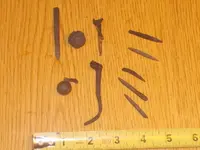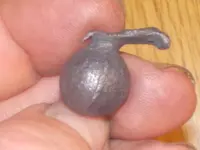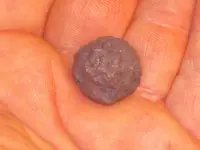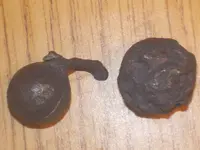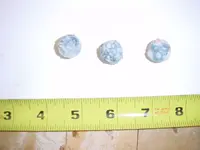You are using an out of date browser. It may not display this or other websites correctly.
You should upgrade or use an alternative browser.
You should upgrade or use an alternative browser.
A few spikes and a couple of interesting musketballs..."bite the bullet"...
- Thread starter Jolly Mon
- Start date
Zodiacdiverdave
Silver Member
- Joined
- Mar 18, 2011
- Messages
- 2,765
- Reaction score
- 1,371
- Golden Thread
- 0
- Location
- The North Atlantic Ocean
- Detector(s) used
- XP Deus, AT Pro, Sea Hunter II, JW Fisher Proton Magnatometer, Shovel, Hammer and chisel
- Primary Interest:
- All Treasure Hunting
Nice finds, did you find these diving or on the beach somewhere.
Sure does look like someone was chewing on that MB. I like the unique ones like those two MB you found, anyone can find an ordinary round one.
ZDD
Sure does look like someone was chewing on that MB. I like the unique ones like those two MB you found, anyone can find an ordinary round one.
ZDD
Jolly Mon
Hero Member
- Joined
- Sep 3, 2012
- Messages
- 868
- Reaction score
- 631
- Golden Thread
- 0
- Primary Interest:
- All Treasure Hunting
- #3
Thread Owner
I found them wading around low tide yesterday, actually. Sometimes stuff just strikes me as interesting...in this case the "chewed" musketball...and the one with the long sprue...
I have heard several theories regarding chewed balls...
Some say they are the result of field hospital use prior to the availability of anesthesia...injured folks "biting the bullet" while undergoing amputations, having limbs set, etc.
Others say use such as this is largely a myth and chewed rounds are the result of being "hit by plows" or chewing by pigs or other animals. I have no idea. But I found the chewed ball several feet below MLLW and I strongly believe it is associated with a sunken vessel of some sort...I think this might mitigate against the "plow" or "pig" theory, at least slightly...
Here are photos of some lead ammunition...the rounds on the left were recovered from submerged marine environments, the ones on the right from terrestrial sites...
No cleaning has been done.
It is remarkable how well lead can be preserved after being buried in salt water muck for 150+ years...
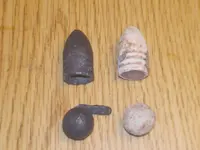
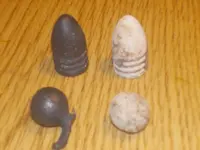
I have heard several theories regarding chewed balls...
Some say they are the result of field hospital use prior to the availability of anesthesia...injured folks "biting the bullet" while undergoing amputations, having limbs set, etc.
Others say use such as this is largely a myth and chewed rounds are the result of being "hit by plows" or chewing by pigs or other animals. I have no idea. But I found the chewed ball several feet below MLLW and I strongly believe it is associated with a sunken vessel of some sort...I think this might mitigate against the "plow" or "pig" theory, at least slightly...
Here are photos of some lead ammunition...the rounds on the left were recovered from submerged marine environments, the ones on the right from terrestrial sites...
No cleaning has been done.
It is remarkable how well lead can be preserved after being buried in salt water muck for 150+ years...


Salvor6
Silver Member
- Joined
- Feb 5, 2005
- Messages
- 3,760
- Reaction score
- 2,181
- Golden Thread
- 0
- Location
- Port Richey, Florida
- Detector(s) used
- Aquapulse, J.W. Fisher Proton 3, Pulse Star II, Detector Pro Headhunter, AK-47
- Primary Interest:
- Shipwrecks
I have seen multiple bullet molds that had a "runner". You pour the molten lead into the mold and it fills several holes at the same time. When the balls come out, you just clip the runner off. These could be balls that have not been "clipped" yet.
Jolly Mon
Hero Member
- Joined
- Sep 3, 2012
- Messages
- 868
- Reaction score
- 631
- Golden Thread
- 0
- Primary Interest:
- All Treasure Hunting
- #5
Thread Owner
I have seen multiple bullet molds that had a "runner". You pour the molten lead into the mold and it fills several holes at the same time. When the balls come out, you just clip the runner off. These could be balls that have not been "clipped" yet.
Yes, exactly. Here is a beautiful example of an old "gang mold", as they are called:
 click to enlarge
click to enlargeYou can see the channel at the top. After casting, the individual "rounds" would be joined by a thin strip of lead and then trimmed by hand.
I would dearly love to find a mold like this...
maipenrai
Bronze Member
- Joined
- Nov 11, 2010
- Messages
- 1,145
- Reaction score
- 242
- Golden Thread
- 0
- Location
- Thailand/Europe/California
- Detector(s) used
- Excalibur 2 1000
- Primary Interest:
- All Treasure Hunting
I would think just any old stick would be better than biting a bullit, but who knows. Must be some stories by doctors or other workers in the field, that can give more light on the subject.
Jolly Mon
Hero Member
- Joined
- Sep 3, 2012
- Messages
- 868
- Reaction score
- 631
- Golden Thread
- 0
- Primary Interest:
- All Treasure Hunting
- #7
Thread Owner
I would think just any old stick would be better than biting a bullit, but who knows. Must be some stories by doctors or other workers in the field, that can give more light on the subject.
Perhaps boredom. Or fear. Or malice.
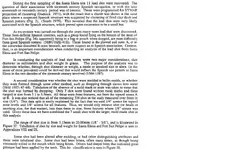
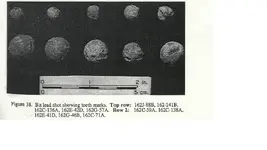
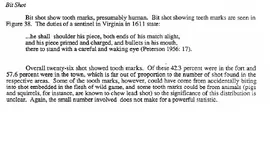
click to enlarge
A chewed round MIGHT be a clue as to historical age and military connection in this context...
I am no expert on antique firearms, but it seems to me that by the time of the evolution of the flintlock mechanism, there would be no need for a soldier to hold a round in his mouth while at the ready...
But there are other possibilities in terms of motive: Boston 1775: “Both poisoned and chewed the musket balls”
Last edited:
CaribbeanDiver
Full Member
PhipsFolly
Hero Member
- Joined
- Sep 30, 2005
- Messages
- 639
- Reaction score
- 614
- Golden Thread
- 0
- Location
- Treasure Coast, Florida
- Detector(s) used
- Minelab Sovereign Elite & Sovereign XS, Minelab Equinox 800 and Aquapulse AQ1B
- Primary Interest:
- All Treasure Hunting
I have numerous musketballs from Port Royal with teeth marks in them...
Too bad there's no dental records from the 1600's... Could have some famous pirates teeth marks in these!! (Hehehe)
Too bad there's no dental records from the 1600's... Could have some famous pirates teeth marks in these!! (Hehehe)
Oceanscience
Full Member
When you dig carefully in sand and mud, you often uncover a large worm. The first thing you see, is a round grey blob that looks just like a musket ball. When you spend some time digging in the same area, the fish learn to wait at your elbow and quickly grab the worm and pull it out. It stretches up to more than a foot length but they either pull it out completely or rip it and sometimes several fight over it. At a shipwreck with musket balls, sometimes what appears is a musket ball. As it looks identical to the worm, the fish grabs it, bites on it and then drops it again a few feet away. Another fish may then pick it up and drop it again. When you pick up this musket ball, you see the fresh bite marks.Perhaps boredom. Or fear. Or malice.View attachment 712538View attachment 712539View attachment 712540click to enlargeA chewed round MIGHT be a clue as to historical age and military connection in this context...I am no expert on antique firearms, but it seems to me that by the time of the evolution of the flintlock mechanism, there would be no need for a soldier to hold a round in his mouth while at the ready...But there are other possibilities in terms of motive: Boston 1775: “Both poisoned and chewed the musket balls”
Salvor6
Silver Member
- Joined
- Feb 5, 2005
- Messages
- 3,760
- Reaction score
- 2,181
- Golden Thread
- 0
- Location
- Port Richey, Florida
- Detector(s) used
- Aquapulse, J.W. Fisher Proton 3, Pulse Star II, Detector Pro Headhunter, AK-47
- Primary Interest:
- Shipwrecks
Can you tell the difference between a fish tooth mark and a human tooth?
CaribbeanDiver
Full Member
Ridiculous. Yes some fish will grab them. No they do not make marks on them anywhere need the deep indentation of a tooth.
huntsman53
Gold Member
- Joined
- Jun 11, 2013
- Messages
- 6,955
- Reaction score
- 6,772
- Golden Thread
- 0
- Location
- East Tennessee
- Primary Interest:
- Other
If that is actually a musket ball in pic #4 and on the right in pic#5, then the person that had it did more than just bite on it. Maybe they had it in their' mouth while trying to ride out the hurricane that sunk their' ship and was chewing on it nervously. I am leaning towards something other than a musket ball but if in fact it is, it may have had just the right amount of impurities mixed in with the lead that corroded/rusted away over some 150 years or more.
MPH200
Sr. Member
- Joined
- Oct 26, 2012
- Messages
- 426
- Reaction score
- 677
- Golden Thread
- 0
- Location
- Austin, Texas
- Detector(s) used
- Minelab Explorer SE
- Primary Interest:
- Shipwrecks
Do you realize this thread is from 2012?
huntsman53
Gold Member
- Joined
- Jun 11, 2013
- Messages
- 6,955
- Reaction score
- 6,772
- Golden Thread
- 0
- Location
- East Tennessee
- Primary Interest:
- Other
Do you realize this thread is from 2012?
LOL, I do now!!
Trez
Hero Member
- Joined
- May 10, 2006
- Messages
- 768
- Reaction score
- 269
- Golden Thread
- 0
- Detector(s) used
- Sov Elite, CZ20, Minelab Sovereign XS, Explorer II, My eyeballs to bloody fingers have done me well also.
- Primary Interest:
- All Treasure Hunting
Yes the thread is old but so were his finds and always welcomed refresh to maybe spark someones knowledge.
Here is a site that has very good information on lead shot (click on some of the highlighted blue lettering to open further into that link) some really great information on many various leads.
A Woodsrunner's Diary: More on Small Shot for Smoothbores.
Fire Away !!!!
Trez
Here is a site that has very good information on lead shot (click on some of the highlighted blue lettering to open further into that link) some really great information on many various leads.
A Woodsrunner's Diary: More on Small Shot for Smoothbores.
Fire Away !!!!
Trez
CaribbeanDiver
Full Member
Still good information... Are you implying when something is old it loses value, lol.
I read an account recently that stated some Captains were brutal, beating sailors daily to maintain discipline and when the sailor was beaten he would "bite the bullet", which would account for such a high number of teeth mark musket balls on some ships, and none on others.
I read an account recently that stated some Captains were brutal, beating sailors daily to maintain discipline and when the sailor was beaten he would "bite the bullet", which would account for such a high number of teeth mark musket balls on some ships, and none on others.
Similar threads
- Replies
- 22
- Views
- 767
- Replies
- 3
- Views
- 226
Users who are viewing this thread
Total: 1 (members: 0, guests: 1)

